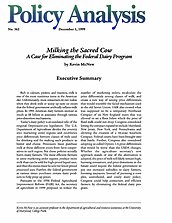Today’s dairy policy is an outdated relic of the original Depression-era legislation. The U.S. Department of Agriculture divides the country into marketing order regions and establishes price differentials between classes of milk used for drinking and for making such products as butter and cheese. Processors must purchase milk at those different prices from farm cooperatives in each region. But those policies actually harm many farmers. The most efficient farmers in some marketing order regions produce more milk than can be sold for high-priced liquid uses, and thus the excess must be sold for lower-priced processed uses. Further, the federal government at various times purchases certain dairy products to help prop up prices.
Pursuant to the 1996 Federal Agricultural Improvement Reform (FAIR) Act, the secretary of agriculture in 1999 proposed to reduce the number of marketing orders, recalculate the price differentials among classes of milk, and create a new way of setting price differentials that would resemble the failed mechanism used in the old Soviet Union. FAIR also created what was supposed to be a temporary Northeast Compact of six New England states that was allowed to set a floor below which the price of fluid milk could not drop. Congress considered letting the compact expand to include Maryland, New Jersey, New York, and Pennsylvania and allowing the creation of a 16-state Southern Compact. Federal courts have been brought into that battle. Further, Congress also considered adopting so-called Option 1‑A price differentials that would be worse than the USDA changes. Whether the agriculture secretary’s new approach stands or one of the alternatives is adopted, the price of milk will likely remain high, harming consumers, and price distortions in the future could require the federal government to pay out increased subsidies to dairy farmers, harming taxpayers. Instead of pursuing a complex, convoluted, and costly dairy policy, Congress could help consumers and efficient farmers by eliminating the federal dairy program.

